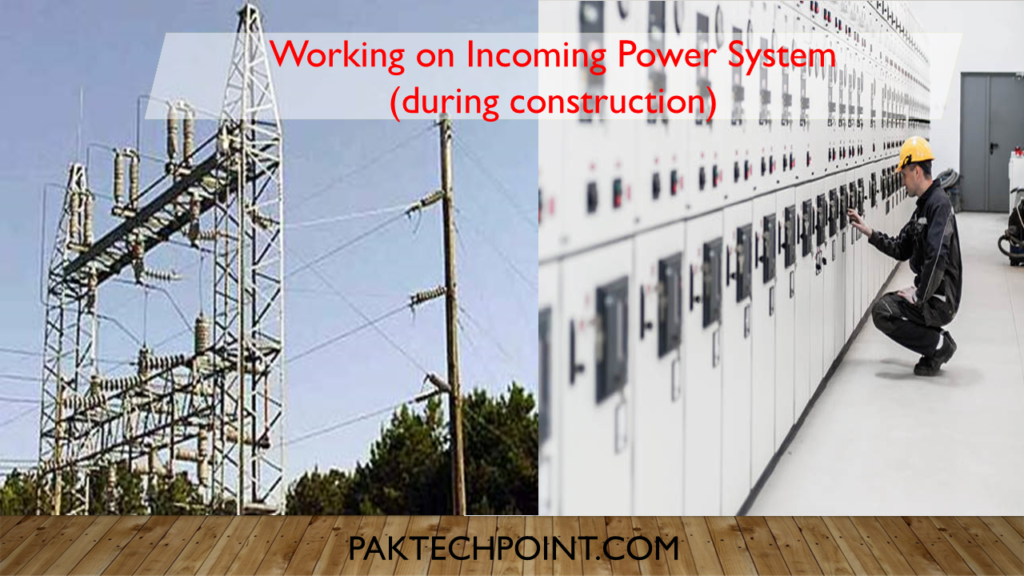This article is about for those engineers who are working on live electrical power system and doing maintenance or installing new equipment. What precautions and procedures they should follow.

Working on Incoming Power System
1. Coordination for Incoming Power Work: Prior to conducting any work on incoming power supplies, including electrical service entrance lines from utilities or customer feeds, the contractor must obtain prior notification and approval from either the field representative engineer or an Electrical Engineering department representative.
2. Location of Safety Grounds: Safety grounds should be installed at the point where the incoming power supply connects to the facility’s distribution equipment. These grounds can be temporarily removed during the connection of incoming power lines but must be promptly reconnected after the power lines’ installation is complete. Safety grounds must remain connected until the power system is ready to be energized. The location of safety ground connections should be documented on the facility’s Safety Work Permit form and appropriately tagged as part of the lock-out tag-out process.
3. Substation Construction and Energization: For new substations at site locations or additions to existing facilities, representatives will maintain communication with the incoming power supplier throughout the substation’s construction. This ensures control over the energization process, scheduling the connection of incoming power lines to align with the substation’s readiness.
The same requirements apply when receiving incoming power from a customer’s third-party facility. Representatives Engineer will communicate with the customer’s representative to maintain control over the energization process.
4. Safety Work Permit System for Safety Grounds: A visible line break is preferred over an open switch until it’s time to energize the substation. After terminating incoming power cables, all activities within the substation, including isolating incoming power lines, must be controlled using the Safety Work Permit system. This helps protect workers from hazardous energy resulting from unintentional energization. For work within specified distances from energized power conductors, or when work is performed on energized lines, the power to the substation should be disconnected by the power supplier. This involves disconnecting incoming power outside the substation, locking, and tagging all switches within the substation in the open position.
Safety Grounds for Incoming Power Lines: Safety grounds must be installed on all incoming power lines as soon as they are installed. Whenever possible, these grounds should be installed in a manner that avoids removal during construction work. Safety grounds must remain connected until the power system is ready to be energized.
5. Review of Electrical Contract: The electrical contract for substation erection will be reviewed by the Construction Department to ensure it specifies the installation of grounding straps at the proper locations. Grounding straps must be installed before connecting any incoming power lines to the substation. These grounding straps should have the appropriate capacity and be installed regardless of the presence of safety grounds or safety ground switches in incoming lines.
6. Method of Attachment: The method for attaching safety grounds should be discussed with the Field representative engineer or a Electrical Engineering department representative. Safety grounds can be installed across all phase legs to ground or individually from each phase leg to ground. They should preferably connect to the nearest available grounding electrode system conductor. The entire safety ground connection from incoming power line to ground must be visible from a single location.
The contractor is responsible for providing all required safety grounding cables. These conductors’ size should be based on the available fault current rating of the incoming power supply but should not be smaller than #2/0 AWG stranded copper. Suitable connection clamps must be provided, matching the equipment to which the safety grounds are connected. The contractor must ensure that safety grounding cables are properly tested and maintained in good working order, avoiding installation if there are signs of damage.
7. Communication with Power Supplier: When the incoming power supplier needs to temporarily de-energize the system, Representatives should maintain communication with the power supplier’s representatives. They should also notify the power supplier when it’s safe to restore power to the facility.
8. Back Feeds Awareness: All personnel involved in the construction of the incoming power system should be aware of the potential for back feeds from the low voltage system to the high voltage system if transformers are connected and power is inadvertently applied to the low side of a transformer.
9. Removal of Safety Grounds: After completing facility construction and before the initial energization of the incoming power supply, all safety grounds must be removed. The location of each safety ground should be inspected by the field representative, a Electrical Engineering Department representative, or both as applicable. This inspection ensures that safety grounds have been removed.
After verifying the removal of all safety grounds, the Electrical Engineering Department should notify the incoming power supplier that it’s safe to energize the system for the first time. The responsibility for this notification should be determined mutually before the final inspection of safety ground removal as described in paragraph no. 9.